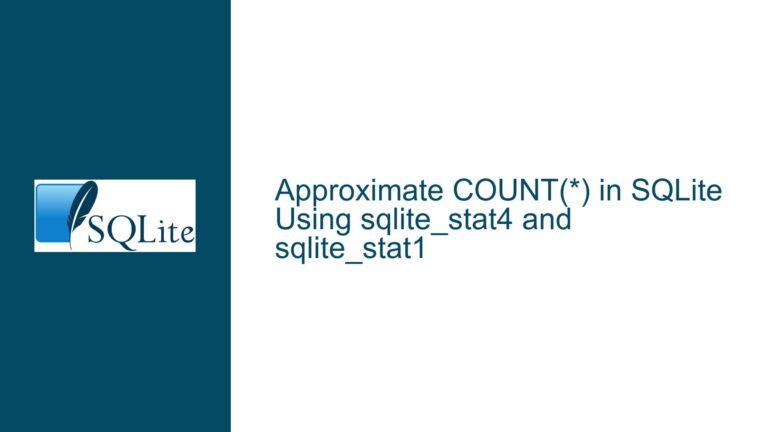Recursive Trigger Causing Exponential Growth in SQLite Table
Issue Overview: Recursive Trigger Leading to Exponential Row Insertion
The core issue revolves around a recursive trigger in SQLite that causes an exponential increase in the number of rows in a table, leading to what appears to be a "hang" but is actually the database performing an exponentially growing amount of work. The trigger is defined in such a way that every insertion into the table v0 results in additional insertions, which in turn trigger the same logic again. This creates a feedback loop where the number of rows in the table grows quadratically with each iteration, causing the database to become unresponsive as it processes an ever-increasing workload.
The problem is exacerbated by the fact that the trigger performs a SELECT statement that joins the table v0 with itself, effectively squaring the number of rows processed with each iteration. The random() function used in the SELECT statement adds further complexity, as it introduces non-deterministic behavior, making it difficult to predict the exact number of rows that will be inserted during each trigger execution. This combination of recursive triggers, self-joins, and non-deterministic functions creates a scenario where the database is forced to perform an impractical amount of work, leading to the observed "hang."
Possible Causes: Recursive Trigger Logic and Self-Joins
The primary cause of the issue lies in the design of the trigger and the table schema. The trigger x is defined to fire on every INSERT operation on the table v0. Within the trigger, an INSERT INTO v0 SELECT ... statement is executed, which selects from the same table v0 and inserts the results back into it. This creates a recursive loop where each insertion triggers another insertion, leading to an exponential growth in the number of rows.
The self-join in the SELECT statement (FROM v0, v0) further compounds the problem. When a table is joined with itself, the number of rows in the result set is the square of the number of rows in the original table. For example, if the table v0 contains 10 rows, the self-join will produce 100 rows. If the table contains 100 rows, the self-join will produce 10,000 rows, and so on. This quadratic growth quickly becomes unmanageable, especially when combined with the recursive nature of the trigger.
The use of the random() function in the SELECT statement introduces additional complexity. Since random() generates a non-deterministic value, the number of rows inserted during each trigger execution can vary, making it difficult to predict or control the growth of the table. This non-determinism can also lead to unexpected behavior, such as the insertion of duplicate rows or rows with invalid data, further complicating the situation.
The CHECK constraint on the v1 column of the table v0 also plays a role in the issue. The constraint is defined as CHECK( NOT ( v1 % NOT NOT ( NOT ( v1 * 3 ) > v1 ) AND ( v1 = 0 OR v1 = 0 ) ) ), which is a complex and potentially confusing expression. While the constraint itself does not directly cause the exponential growth, it adds to the overall complexity of the schema and may contribute to the database’s inability to efficiently process the large number of rows being inserted.
Troubleshooting Steps, Solutions & Fixes: Addressing Recursive Triggers and Exponential Growth
To resolve the issue, it is necessary to address the root causes of the exponential growth in the table v0. This can be achieved through a combination of schema redesign, trigger modification, and query optimization.
Schema Redesign: The first step is to reconsider the schema of the table v0. The CHECK constraint on the v1 column should be simplified or removed if it is not strictly necessary. Complex constraints can slow down insert operations, especially when dealing with a large number of rows. Additionally, the data type of the v1 column should be carefully chosen to ensure that it can efficiently store the expected range of values. In this case, the VARCHAR(24) data type may not be appropriate for storing numeric values, and a more suitable data type such as INTEGER or REAL should be considered.
Trigger Modification: The recursive trigger x should be modified or removed to prevent the exponential growth of the table. One approach is to limit the number of times the trigger can fire within a single transaction. This can be achieved by introducing a counter variable that tracks the number of trigger executions and stops further executions once a certain threshold is reached. Alternatively, the trigger logic can be redesigned to avoid self-joins and recursive insertions. For example, the trigger could be modified to insert rows into a separate table rather than back into v0, thereby breaking the recursive loop.
Query Optimization: The SELECT statement within the trigger should be optimized to reduce the number of rows processed. The self-join (FROM v0, v0) should be avoided, as it leads to quadratic growth in the number of rows. Instead, the query should be rewritten to use a more efficient join or to eliminate the need for a join altogether. The use of the random() function should also be reconsidered, as it introduces non-deterministic behavior that can complicate the query and lead to unpredictable results. If randomness is required, it may be better to generate the random values outside of the database and pass them as parameters to the query.
Testing and Monitoring: After making the necessary changes, the database should be thoroughly tested to ensure that the issue has been resolved. This includes testing the trigger logic to verify that it no longer causes exponential growth in the table, as well as monitoring the database’s performance to ensure that it can handle the expected workload. Tools such as SQLite’s EXPLAIN command can be used to analyze the execution plan of the queries and identify any potential bottlenecks.
Alternative Approaches: In some cases, it may be necessary to consider alternative approaches to achieve the desired functionality without using recursive triggers. For example, instead of using a trigger to insert rows into the table, the logic could be implemented in the application layer, where it can be more easily controlled and monitored. Alternatively, a stored procedure or script could be used to perform the necessary operations in a controlled manner, avoiding the pitfalls of recursive triggers.
By addressing the root causes of the exponential growth and implementing the necessary changes to the schema, trigger logic, and queries, the issue can be resolved, and the database can be restored to a stable and performant state.






